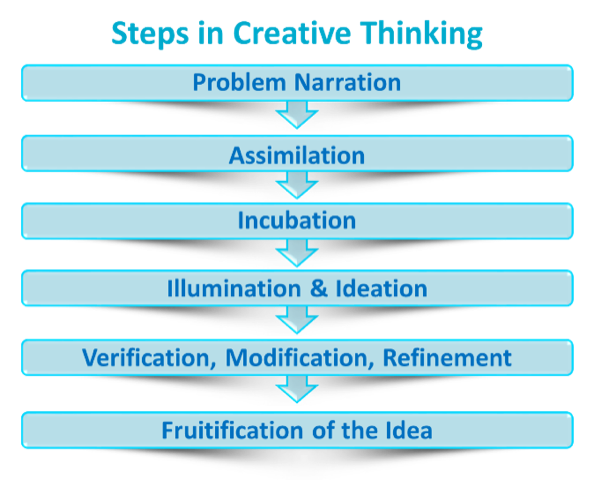Creative thinking and solutions is not just restricted to developing ideas to crack marketing or an advertising problem, but need to be viewed in a far larger context – as a problem solver in our lives. In in all walks of life, we are often faced with problems and the first thing we do is to think linear solutions. When we say we are doing things creatively, it means doing things differently, off the beaten track, to arrive at the desired solution often inspired by analogies, methodologies and tactics borrowed from completely unrelated spheres.
I firmly believe Creativity is a process, not an end by itself. It is manifested overtly or subtly in a creatively inclined mind, which has the innate talent to think laterally and take leaps within the framework of the defined problem he is expected to solve. It is necessary to fully understand and immerse into the problem and set your thinking in motion to come to a solution. I have tried to give a basic structure to this thinking-in-motion to make it simple and easy to remember.
Let me illustrate this process with a live example on advertising from my portfolio of experiences. Nando’s, a global QSR leader from South Africa in flame-grilled peri-peri chicken, entered the Indian market a few years back. They were relatively unknown compared to the big boys like KFC, Dominos, Pizza Hut all of whom had entry level pricing below Rs.100 to attract the first trials and footfall. Being makers of authentic flame-grilled chicken, Nando’s pricing was a barrier. And this soon became such an overwhelming perception that even when they introduced a few dishes at sub Rs. 100, prospects didn’t even notice. The single-minded task of the agency was to break this current perception & present Nando’s as pocket-friendly QSR option, without compromising on its core DNA of being the specialists in flame-grilled chicken.
A task-force of Account Planning & Creative talents at BEI Confluence was set up that followed the classical route of the Brain-storming Process to encourage lateral and disruptive ideas. The gist below is a live example of structured creative thinking conforming to the given matrix.

INSERT Chart: Steps in Creative Thinking
- Problem Narration: Should be Structured & Succinct
- Nando’s offerings are perceived as expensive
- Task was to break this perception & present Nando’s as pocket-friendly for everyone
- Assimilation: Understanding of the Problem & Issues
- Everyone starting from leaders like KFC, Pizza Hut, McD, Dominos focused on their entry point pricing to attract footfalls. Our job was to cut the clutter in communicating the same message differently
- Incubation: Sleeping on the problem by parking the brief in sub-conscious
- Team was encouraged sleep over the problem and tasked to think disruptively, and come up with ideas two days later
- Illumination & Ideation: The Eureka Moment of Idea Generation
- An ideas session through brain-storming was conducted two days later and teams encouraged to narrate the wildest ideas that would ‘shake & jerk’ (defined as urban upmarket millennials & GenZ)
- About 20 ideas (analogical, divergent, bizarre, comical) were discussed, and the ‘hitch-hiking’ approach was used by moderator to arrive at the best five ‘out-of-the-box’ ideas to build on further. (‘Hitch-Hiking’ approach is defined someone else building on another person’s ideas without criticizing it)

INSERT: Nando’s grilled the chicken Logo
- Verification, Modification, Refinement: Review & Sharpening Ideas
- Five ideas were then presented to a group of 4 senior professionals to review
- They were outlined the problem, the task was defined and were asked to choose the two most striking ideas, that are relevant but disruptive to the problem’s solution
- Further round of hitch-hiking was done and the group finally arrived at the most striking idea stream
- Fructification of the Idea: Honing down to one or two ideas & review execution
- A team of 4 creative persons divided in 2 groups were tasked to now develop a few KVs & film scripts based on the two shortlisted ideas
The final idea selected was based on the thinking that while Nando’s grilled the chicken, why can’t we let the customer ‘Grill the Bill’? In other words, the bill is so pocket-friendly that the customer actually got a ‘grilled bill’ along with the grilled chicken.
GRILL THE BILL TVC:
Marketing & advertising is only a small part of the vast canvas where creative thinking is used as a problem-solving tool, and its greater application comes from vast areas such as science & technology, geology, aeronautics, ship building, economics, defence, medical science, health care, IT and software, business and commerce where innovative out-of-the-box solutions are critical for inventions, innovations, time and energy saving solutions that are helping the human race advance at a break-neck speed.

INSERT COLLAGE OF IMAGE WHALE, HELICOPTER etc…
Analogical references drawn from animal world, planetary systems, nature, biological and anatomical systems are often great inspirations for creatively solving problems by drawing analogies and adapting these to arrive at the solutions we are seeking. The submarine’s original inspiration was the whale which scientist William Bourne had drawn out in late 1578 and it was not till 1620 when Cornelis Drebbel, the Dutch inventor tested the prototype successfully.
In the area of science & technology, a more advanced technique known as “Synectics” (Dictionery meaning: A problem-solving technique which seeks to promote creative thinking, typically amongst small groups of people of diverse expertise) that creates a psychological strain that can lead to original solutions primarily through analogical matrix in a group.
There are numerous examples of scientific inventions inspired from the parallel world of nature, human anatomy, planetary systems (used extensively in Space technology) that have inspired great breakthroughs and innovations that have revolutionised our lives. Many of these have been a result of the usage of the advanced Synectics techniques using the Analogical Matrix.
The reason I have brought this technique in focus is to encourage the creative community in advertising to think through analogically by drawing parallels from numerous ‘worlds’ and provide clutter-breaking ideas that can stick like a glue in the people’s mind.

















